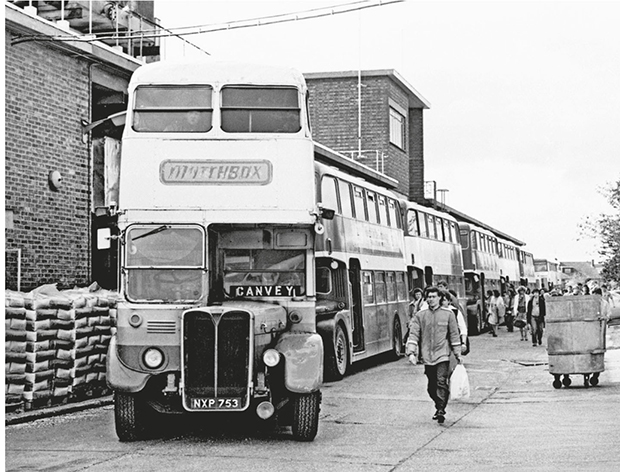Matchbox memories: the toy car factory that dominated Hackney’s industrial landscape

By-gone days: The Lesney Products factory in Hackney Wick
For many grown men Matchbox toy cars evoke childhood memories of afternoons spent driving over mountainous sofas and screeching around table-leg bends. For others, bargain hunters and boot-sale stalkers, they can now mean five figure sums.
Yet in a new book, motoring journalist Giles Chapman reveals the key to the success of these miniature must-haves was the army of Hackney women hired by Lesney Products – the firm behind Matchbox toys – to produce them.
With bonnets, boots and windows that opened, as well as diggers and trucks with off-loadable cargo, Matchbox’s attention to detail meant that by the 1960s their fleet of miniature cars was at the top of every boy’s Christmas list.
Industrial landscape
And with rising demand came a domination of Hackney’s industrial landscape.
By 1959 Lesney appeared to occupy just about every existing building in Eastway by Hackney Marshes.
But Lesney’s crowning glory, a result of Matchbox’s success, was its gigantic factory, which until 2010 stood proudly beside the canal on Lee Conservancy Road by Mabley Green.
Completed in 1963, the imposing concrete giant became an instant local landmark. By 1966 its workforce stood at 3,600 and, Chapman notes “was easily the largest employer in the borough of Hackney”.
With a brand new factory and demand at an all-time high, Lesney needed labour and they found it in the armies of local women who worked full and part-time on the assembly lines.
The pay was competitive and, Chapman says: “Leslie Smith, the director of Lesney, came up with a novel brainwave to make sure the Matchbox conveyor belt would never be wanting for nimble assembly hands”.
Perks of the job
To entice the women of Hackney to join the Matchbox ranks Lesney bought a fleet of redundant buses from London Transport, painted them in Matchbox’s trademark blue and yellow colours and offered free transport to and from work, as well as help with the school run for their children.
Chapman adds: “Unsurprisingly with this perk, there was never any shortage of potential employees despite the fact that such tasks as assembling the vehicles, applying the stickers and packaging the final products, can’t have been anything but deathly dull.”

Transport hub: Buses used by Lesney to transport its workforce
Yet camaraderie and a good working atmosphere prevailed in the Lesney factory.
Len Mills, a former tooling and engineering manager recalled: “It was like a family. Lesney was not so much a job as a way of life.”
In 1967 Lesney, with the help of its largely female workforce, was awarded its place in The Guinness Book of Records when its annual output reached 100 million models and by 1969 output had soared to a million units a day.
Alan Anderson, whose mother Mary took up a part-time job at the factory in the mid-1960s, recalls her setting off for work each night after he’d come home from school and had his tea: “Her job was in effect quality control. Dud ones were binned but quite a few fell in handbags, quite innocently I’d imagine.
“Often, however, fully-built cars found their way there, too. I think my nephews have them now, in a tailor-made Matchbox storage case. I shudder to think their worth due to sheer rarity if my brother and I hadn’t played with them!”
Though Lesney’s Matchbox range ceased production in September 1982, its legacy continues today, in the memories of those who played with them and for the collectors who are cursing the same boys for racing their miniature Mercedes along curbs and smashing them up whilst playing at rally racing in the mud.
Britain’s Toy Car Wars: Dinky vs Corgi vs Matchbox is published by the History Press. ISBN: 9780750965941. RRP: £20

Coupé-d up: A Matchbox sports car

I worked at Lesley’s for 11years in the plastic injection has a setter loved every minute working there met many friends also played for there football team hard work but well paid .I started there after leaving setrights as a tool maker but I wanted to work on the machines & I got my wish.
Hi, I was there , from 1977 to 1979, as a young lad of fifteen from Ireland , I was trained as a setter, and then they put in with the two fitters Stan and George, there was a little Welsh lad there too taffy , he used to fill the hoppers , for the injection machines , loved my time there , Brian cook was a charge hand , an I think the foreman’s name was Roy , big canteen , food was good, sad it’s gone , would love to find others that worked there ,
Hi I don’t knowif you will read this, but I am looking for or any information you can give me on my father who worked at lesneys, it would have been in the late 60’s, please any information at all will do, or where I can find some thank you.
My name was is Margaret dipchand, my mother and sister worked there as well,
Hi Rodney ,I worked on your
machines in the plastics dept remember stan phil and quite a few others .
My stepdad Maurice Pereira worked at Lesneys we moved out of London around 1973/74. He used to bring me the “rejects” so at one point I had a few cars / vans and I enjoyed opening the doors and boot LOL
Worked at lee con for about 10 years started in 1968 worked as setter on the assembly line and later on the auto labeling machine
Loved every minute. L gildersleve